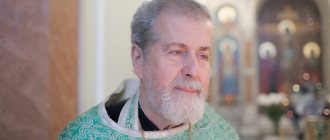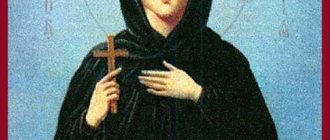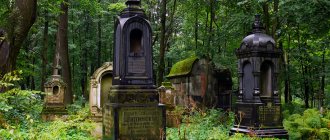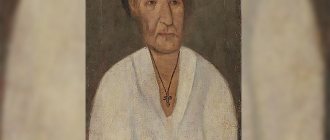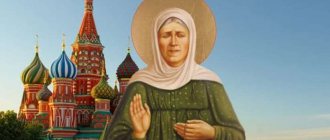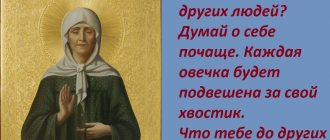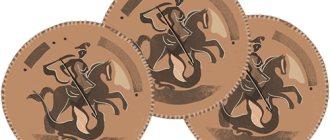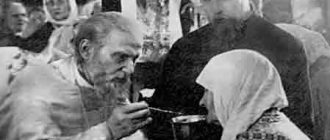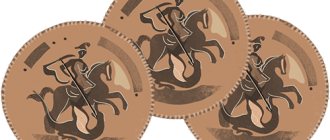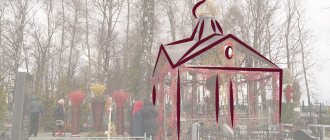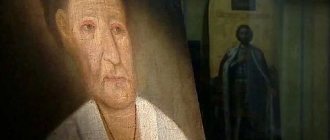How to get there
Matrona's grave is located on Obukhovskaya Oborony Avenue, 24. The nearest metro station is Alexander Nevsky Square, so believers can combine this trip with a visit to the Alexander Nevsky Lavra.
From the monastery to Matrona’s grave it is only about 1.5 km. In addition, almost at the very courtyard of the Trinity-Zelenetsky Monastery there is a public transport stop “Smolyanaya Street”. From the metro there are buses 8, K-8, 58 and trams 65, 7 and 7A.
The story of Eldress Matrona Barefoot
Matrona Barefoot lived in St. Petersburg just over 100 years ago. Like another saint, Xenia of Petersburg, revered in this city, she also accepted the feat of foolishness.
At any time of the year, even in winter, in severe frosts, Matrona walked barefoot. So she showed the strength of her spirit over the weakness of the human body. For this she was nicknamed the sandal.
Matrona had the gift of insight, healing and the special power of prayer. Rumors about the new St. Petersburg blessed one quickly spread far beyond the city. Every day hundreds of people turned to her for help, and the old woman never refused her help to anyone.
Today Matrona Barefoot is considered a locally revered saint. She is not canonized by the Russian Orthodox Church and few people know about her outside of St. Petersburg. And all because all data about the saints after the revolution was diligently destroyed by the atheists.
Prayer for repose
Remember, O Lord our God, in the faith and hope of the eternal life, Thy servant, blessed Matrona, who passed away, and as the Good and Lover of Mankind, forgiving sins and consuming untruths, weaken, forsake and forgive all her voluntary and involuntary sins, deliver her from eternal torment and the fire of Gehenna , and grant her the participation and enjoyment of Your eternal blessings prepared for those who love You: even if you sin, do not depart from You, and undoubtedly in the Father and the Son and the Holy Spirit, Your glorified God in the Trinity, faith, and the One in the Trinity and the Trinity in Unity, Orthodox even until his last breath of confession. Be merciful to that one, and the faith that is in Thee, instead of deeds, and with Thy saints, as Generous rest: for there is no man who will live and not sin. But You are the One besides all sin, and Your righteousness is righteousness forever, and You are the One God of mercies and generosity, and love for mankind, and we send glory to You, the Father and the Son and the Holy Spirit, now and ever and unto the ages of ages. Amen.
Grave of Matrona Sandals
The tombstone on the grave is completely new, which is not surprising since the saint’s relics were reburied not so long ago. During Soviet times, the authorities tried to erase the names of all saints from people’s memory. Therefore, the tombstone was demolished and the grave was razed to the ground.
Only in the 90s, when the Church of the icon of the “Mother of God Joy of All Who Sorrow” was returned to the jurisdiction of the Russian Orthodox Church, believers organized a search for the grave. And it was literally a miracle that they found her. The coffin was reburied with honors, setting up a grave in a new place with a cross, a marble slab and a fence.
The details of the old woman’s life had to be collected bit by bit - literally raked out from the remains of burnt archives. As a result, it was possible to establish that Matrona was a schema-nun. Moreover, she was very respected in the city, and all St. Petersburg newspapers wrote about her death.
Elder Matrona was personally acquainted and even had a spiritual relationship with John of Kronstadt. An archival photograph has been preserved where they illuminate the new building together. She also took part in several of the famous travels of John of Kronstadt around Russia.
Despite the fact that Matrona Barefoot of St. Petersburg has not been officially canonized, believers go to her grave from the very first minutes of the opening of the temple until darkness. People come with their requests and thanks, and leave notes.
Sister of Holy Charity
Blessed is the man who regards every man as a god, after God.
Venerable Neil of Sinai
In 1814, in the village of Vanina, Kostroma province, a girl was born into the peasant family of the Shcherbinins, they named her Matrona. In addition to Matrona, Peter and Agafya Shcherbinin had sons: Makar, Alexander and Ivan, all of them were engaged in agriculture. Nothing is known about her childhood. Her further life path, it would seem, did not foreshadow anything great. The peasant girl Matryona married a tradesman from the city of Kostroma, Yegor Mylnikov. They lived well, prosperously: their small family had their own house and a grocery store. During the Turkish War of 1877–1878. Her husband was drafted into the army, Matronushka went with him to the front. She became a sister of mercy. Even then, her humble soul, which received the great gift of compassion from God, manifested itself in full. She helped everyone as best she could, and distributed all her meager allowance to the poor soldiers. Her ministry as a Christian woman began in field hospitals; here she saw suffering and death.
It must be said that the war of 1877–1878. was not quite ordinary, it was a war for the independence of our Serbian Christian brothers. The Russian people went to war with the readiness and desire to “die for their friends.” Many Russian women went to the front to serve as sisters of mercy.
What is a sister of mercy? This is not a nurse, as many people think: after all, the vast majority of these women did not have a medical education. The sisters of mercy had the hardest work.
This is how V.I. Nemirovich-Danchenko, a contemporary of those events, described the working day of the sisters in one of the hospitals:
The day of the sister of mercy began very early. Everyone is still sleeping around, and the nurse on duty is already waking up her friends, asking them to help her... There is a stench and stuffiness in the hospital tents. Candles and lamps flicker dimly in the stuffy air. The wounded know no peace. Moans are heard everywhere. In different places they call their sister. You need to turn the patient over, adjust his pillow, cover him with a blanket. At the same time, even the most menial tasks need to be corrected, because the hospital servants are still sleeping; She was so tired during the day that you couldn’t wake her up with heavenly thunder. Forgetting their old habits and suppressing their aversion to untidy work, the sisters serve the sick even at night. Having worked the day before until late in the evening, they finally managed to rest, but not for long: it was still far from light, and they were already being woken up to go to the ward. Many of the wounded have had their bandages come off, heat the water, wash off the lint, apply bandages again; others need medicine, a third has bleeding through them - the linen is crusted and warped, it needs to be changed, the wounded person himself is not able to do this. Those wounded in the head suffer more than others; They are not aware of anything, they have to forcefully unclench their teeth and pour in medicine. During the night, many people's sheets are ruined - they need to clean the air, change the bed linen... They're up to their necks in work until the morning comes. Finally the doctors appear, but their appearance does not make it any easier for the sisters. Sister, do this and that, hold the patient... Sister, bring some absorbent cotton, give me a splint... Where are the splints? Sister, give me some water... The bandages begin... Every inch of the bandage is removed carefully and carefully, every place soaked with dried blood is soaked; The lint is removed slowly, almost thread by thread, so as not to disturb the fresh wound. Rinse it and bandage it again - this is an easier task. But before this, you need to learn to overcome both shyness and disgust, when the sight of other gaping wounds makes men sick. The sisters had to deal with more difficult dressings. Every touch to a living place is extremely painful for the patient: all this must be done as insensitively as possible for him and at the same time quickly, since hundreds more patients are waiting for their turn.
“What attracted them to wear the emblem of mercy - red crosses on their chests,” one officer wrote in his diary, “and what made them selflessly sacrifice peace, and sometimes even life? If only there were elderly people in their ranks, for whom the time had come to think about atonement for sins and make up for their mistakes with good deeds, then the majority were young people fresh and full of hope. Were they looking for strong sensations, or were they rushing out of everyday, uninteresting life in order to realize that at least once in their lives they had fulfilled the covenant of God the Man?..”
No, Russian women were not looking for strong sensations, they were traveling at the call of a merciful heart.
The concept of “mercy” comes from two words: “mercy” and “heart”. This is a merciful heart, a merciful heart... This is truly a gift from God. A heart capable of grieving even over a fallen angel can only be in a person who loves the Lord with all his soul. It cannot help but sympathize with such a beautiful creation of God, which was created first before God and which, having become proud, depriving itself of the possibility of repentance, perishes irrevocably. A merciful heart does not see evil in a person; it perceives sin not as an integral part of the soul, but as evil introduced into it from the outside, and therefore a merciful person tries with all the strength of his soul to help both moral persons and sinners. He prays for everyone.
Metropolitan John (Snychev)
And these words fully apply to sisters of mercy, such as Matrona, the wife of a simple shopkeeper. After all, a wounded person is a wounded person, whether he is a sinner or a righteous person, he equally needs care and prayer. And Matronushka, taking care of the wounded, did not forget to pray for their souls, giving to her neighbors not only physical strength, but also her own soul. “He is merciful who in his thoughts does not distinguish one from another, but has mercy on everyone,” Russian sisters of mercy put these words of St. Isaac the Syrian into practice every minute. – The merciful not only gives to people from his own, but joyfully endures injustice from others and has mercy on them. The merciful not only gives to people from his own, but also joyfully endures injustice from others and has mercy on them. As the shadow follows the body, so mercy follows humility.”
-Who are these merciful people? - said another monk, Saint Simeon the New Theologian. – Are they the ones who give money to the poor and feed them? No - this is not the only thing that makes one merciful; It is necessary that there be mercy of the heart with this. Or are those merciful who became poor out of love for Christ, who became poor for our sake, remembering the poor, widows, orphans and the sick and not having anything to give them, they suffer mercy for them and cry, like Job, who says about himself: “But weep for all the weak”? (Job.30:25) When they have something, they help those in need with sincere cordiality, and when they do not have it, they give them all-convincing instructions about what contributes to the salvation of the soul, obeying the word of the one who said: “I teach without flattery, without envy I teach.” "(Wis. 7:13). Such are the truly merciful, blessed by the Lord Jesus Christ: with such mercy, like a ladder, they ascend to perfect spiritual purity.
The kindness and selflessness of the sisters of mercy amazed even those who were far from Christ. There are known cases when wounded Turks, having received help in a Russian field hospital, converted to Christianity and received Holy Baptism.
How I saved my son’s life with Holy Baptism
When my son was three months old, he fell ill with bilateral staphylococcal bronchopneumonia. We were urgently hospitalized. He was getting worse and worse. A few days later, the head of the department transferred us to a solitary ward and said that my little one did not have long to live. My grief knew no bounds. I called my mother: “The child is dying unbaptized, what should I do?” Mom immediately went to the temple to see the priest. He gave my mother baptismal water and told me what prayer should be read during Baptism. He said that in emergency cases, when a person is dying, a layman can perform Baptism. Mom brought me baptismal water and texts of prayers.
The room had glass doors, and nurses were constantly scurrying along the corridor. Suddenly at three o'clock their meeting began. Our nurse assigned me to monitor my son's condition while she attended the meeting. I calmly, without interference, baptized my son. Immediately after Baptism, the child came to his senses.
After the meeting, a doctor came in and was terribly surprised: “What happened to him?” I answered: “God helped!” A few days later we left the hospital, and soon I brought my son to church, and the priest completed Holy Baptism.
Valentina, Moscow
Miraculous conversion
There was such a case with my grandmother. She hid her faith from her superiors. One day she was walking with an atheist friend past a temple. There was a service in the church, people were praying. A friend decided to mock the believers. She entered the temple and, while singing prayers, shouted to the whole church: “Why are you praying to Him who is not?” The grandmother tried to take her away, persuading her: “No need, let’s go.” Well, they pray - and let them pray.” But the friend did not want to calm down and said so that everyone could hear: “If there is a God, let me fall and not get up.”
And suddenly she really fell and could not get up. They carried her out, she asked for water and immediately bought an icon. After this, as the grandmother said, that woman became a very religious person, but her illness remained with her until the end of her days. Here's a case...
Galina, Novosibirsk
There are many saints known among the sisters of mercy; it is enough to recall the Venerable Martyr Grand Duchess Elizaveta Feodorovna, who, after the death of her husband, Grand Duke Sergei Alexandrovich, completely devoted herself to works of mercy and became the founder of the Martha and Mary Convent, a monastery where both charitable and medical assistance was provided to the poor.
Icon of the “Mother of God Joy of All Who Sorrow”
Another shrine of this place is the icon of the “Mother of God, Joy of All Who Sorrow.”
This is a special image that many believers know about. It is also called “Our Lady of Pennies.” The thing is that in the 19th century the temple where it was kept was struck by lightning. The building completely burned down, but the icon itself miraculously remained unharmed. But small coins—pennies—were soldered to it.
After that fire, miracles of healing began at the icon. Since then, pilgrims have been coming to her in an endless stream.
